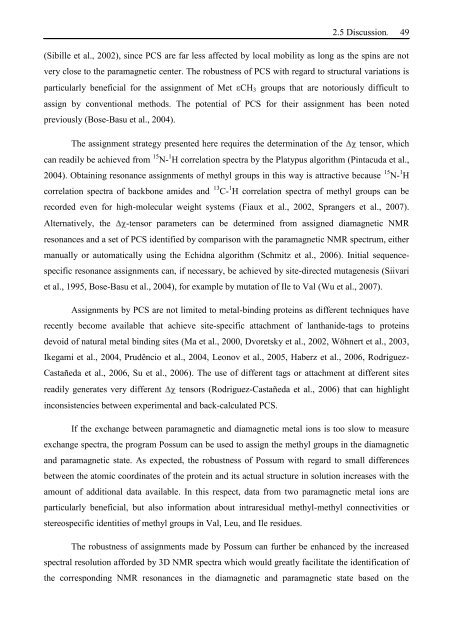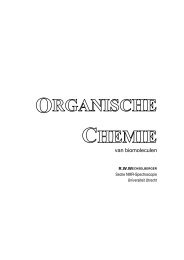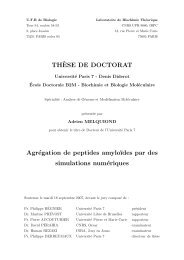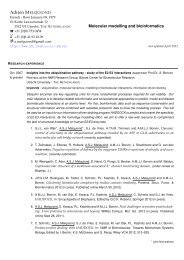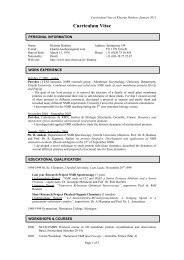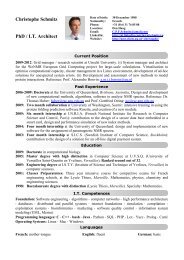Thesis Title: Subtitle - NMR Spectroscopy Research Group
Thesis Title: Subtitle - NMR Spectroscopy Research Group
Thesis Title: Subtitle - NMR Spectroscopy Research Group
You also want an ePaper? Increase the reach of your titles
YUMPU automatically turns print PDFs into web optimized ePapers that Google loves.
2.5 Discussion. 49<br />
(Sibille et al., 2002), since PCS are far less affected by local mobility as long as the spins are not<br />
very close to the paramagnetic center. The robustness of PCS with regard to structural variations is<br />
particularly beneficial for the assignment of Met CH3 groups that are notoriously difficult to<br />
assign by conventional methods. The potential of PCS for their assignment has been noted<br />
previously (Bose-Basu et al., 2004).<br />
The assignment strategy presented here requires the determination of the tensor, which<br />
can readily be achieved from 15 N- 1 H correlation spectra by the Platypus algorithm (Pintacuda et al.,<br />
2004). Obtaining resonance assignments of methyl groups in this way is attractive because 15 N- 1 H<br />
correlation spectra of backbone amides and 13 C- 1 H correlation spectra of methyl groups can be<br />
recorded even for high-molecular weight systems (Fiaux et al., 2002, Sprangers et al., 2007).<br />
Alternatively, the -tensor parameters can be determined from assigned diamagnetic <strong>NMR</strong><br />
resonances and a set of PCS identified by comparison with the paramagnetic <strong>NMR</strong> spectrum, either<br />
manually or automatically using the Echidna algorithm (Schmitz et al., 2006). Initial sequence-<br />
specific resonance assignments can, if necessary, be achieved by site-directed mutagenesis (Siivari<br />
et al., 1995, Bose-Basu et al., 2004), for example by mutation of Ile to Val (Wu et al., 2007).<br />
Assignments by PCS are not limited to metal-binding proteins as different techniques have<br />
recently become available that achieve site-specific attachment of lanthanide-tags to proteins<br />
devoid of natural metal binding sites (Ma et al., 2000, Dvoretsky et al., 2002, Wöhnert et al., 2003,<br />
Ikegami et al., 2004, Prudêncio et al., 2004, Leonov et al., 2005, Haberz et al., 2006, Rodriguez-<br />
Castañeda et al., 2006, Su et al., 2006). The use of different tags or attachment at different sites<br />
readily generates very different tensors (Rodriguez-Castañeda et al., 2006) that can highlight<br />
inconsistencies between experimental and back-calculated PCS.<br />
If the exchange between paramagnetic and diamagnetic metal ions is too slow to measure<br />
exchange spectra, the program Possum can be used to assign the methyl groups in the diamagnetic<br />
and paramagnetic state. As expected, the robustness of Possum with regard to small differences<br />
between the atomic coordinates of the protein and its actual structure in solution increases with the<br />
amount of additional data available. In this respect, data from two paramagnetic metal ions are<br />
particularly beneficial, but also information about intraresidual methyl-methyl connectivities or<br />
stereospecific identities of methyl groups in Val, Leu, and Ile residues.<br />
The robustness of assignments made by Possum can further be enhanced by the increased<br />
spectral resolution afforded by 3D <strong>NMR</strong> spectra which would greatly facilitate the identification of<br />
the corresponding <strong>NMR</strong> resonances in the diamagnetic and paramagnetic state based on the


